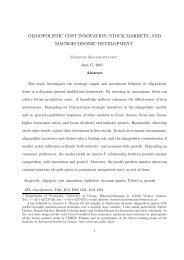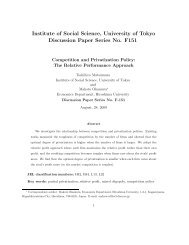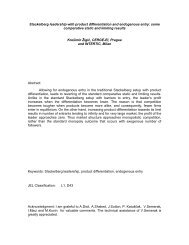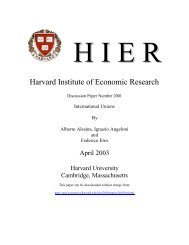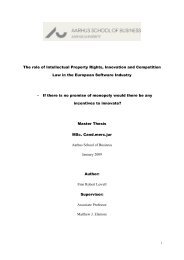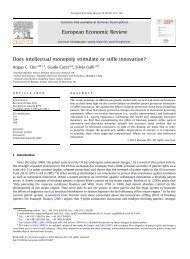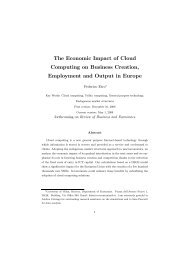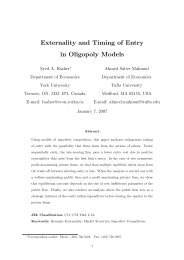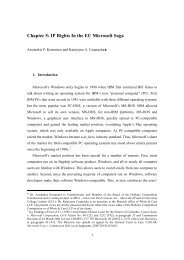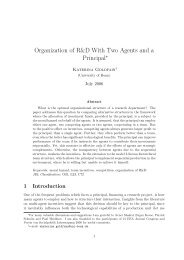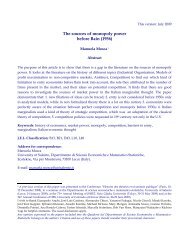The EU Approach to Abuse of Dominance - Intertic
The EU Approach to Abuse of Dominance - Intertic
The EU Approach to Abuse of Dominance - Intertic
Create successful ePaper yourself
Turn your PDF publications into a flip-book with our unique Google optimized e-Paper software.
semiconduc<strong>to</strong>r plant and that a steel worker can be retrained <strong>to</strong> become a s<strong>of</strong>tware engineer without<br />
cost. <strong>The</strong>se assumptions do not reflect economic reality.<br />
Under the Discussion Paper, a dominant company may, even if the price is below the relevant<br />
cost benchmark, rebut a finding <strong>of</strong> preda<strong>to</strong>ry pricing by providing a “justification” for its pricing<br />
behaviour (this is a departure from earlier case-law, where pricing below AVC was considered <strong>to</strong> be<br />
abusive per se). <strong>The</strong> Discussion Paper lists several examples <strong>of</strong> possible justifications (# 131), including an<br />
issue <strong>of</strong> re-start up costs or strong learning effects, the need <strong>to</strong> sell <strong>of</strong>f perishable or obsolete s<strong>to</strong>ck and<br />
the justification that the low price is a short-run loss minimising response <strong>to</strong> changing conditions in the<br />
market (including those resulting from a dramatic fall in demand leading <strong>to</strong> excess capacity). It is<br />
surprising that besides learning effects, the Discussion Paper does not cite network effects, whose<br />
theoretical role in justifying aggressive pricing is very similar <strong>to</strong> that <strong>of</strong> learning by doing.<br />
4. Rebates and Single Branding<br />
<strong>The</strong> Discussion Paper states that “as efficient” competi<strong>to</strong>rs can be foreclosed from the market by<br />
conditional rebates applied by a dominant supplier in particular if the five following cumulative<br />
conditions are met:<br />
(i) the rebates apply <strong>to</strong> all purchases (including past purchases) made within the reference<br />
period, that is they are retroactive;<br />
(ii) the threshold is set at a level that induces switching cus<strong>to</strong>mers <strong>to</strong> buy additional<br />
quantities from the dominant company;<br />
(iii) competi<strong>to</strong>rs’ required share exceeds the commercially viable amount per cus<strong>to</strong>mer (as<br />
calculated by the Commission on the basis <strong>of</strong> the dominant company’s ATC and the<br />
effective price <strong>of</strong> the last slice <strong>of</strong> the rebate). If the basic price <strong>of</strong> the dominant firm is p,<br />
the percentage rebate is r, <strong>to</strong>tal sales are S+X, <strong>of</strong> which S is the threshold above which<br />
rebates start and X are the extra sales beyond the threshold, then the effective price for<br />
the same extra fraction <strong>of</strong> sales is given by the difference between <strong>to</strong>tal price with the<br />
rebate p(1-r)(S+X) and the <strong>to</strong>tal price <strong>of</strong> the threshold quantity without rebates pS,<br />
divided by the extra quantity X:<br />
p(1<br />
− r)(<br />
S + X ) − pS ⎛ r(<br />
S + X ) ⎞ ⎛ r ⎞<br />
EP =<br />
= p⎜1−<br />
⎟ = p⎜1<br />
− ⎟<br />
X<br />
⎝ X ⎠ ⎝ x ⎠<br />
where we defined x=X/(S+X) the fraction <strong>of</strong> extra sales. When this average price is<br />
below the average <strong>to</strong>tal cost ATC entry is foreclosed. Assuming that ATC is constant<br />
and equal <strong>to</strong> c, the necessary condition can be derived. A competi<strong>to</strong>r with the same<br />
12



